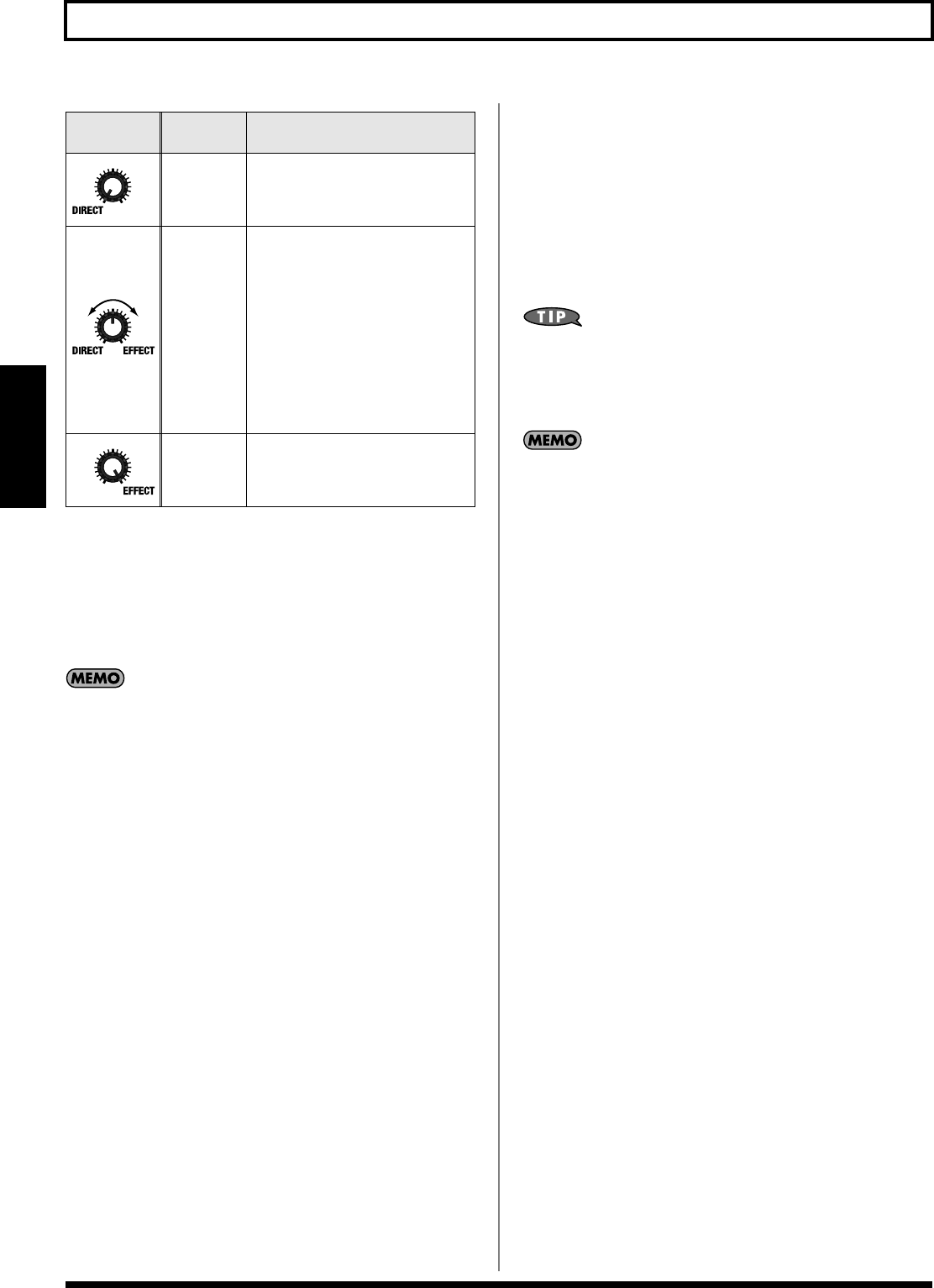
12
Panel descriptions
* Regardless of the knob position, the effects are bypassed when
nothing is connected to the EFFECT RETURN jack.
* With a series connection, no sound is output from the D-
BASS when the volume of the external effects processor is
turned down completely or the effects processor’s power is
turned off.
• Series-Connected Effects
Effects that change the source sound itself
Ex.) Equalizer, Limiter, Distortion, Wah, Chorus, Flanger
• Parallel-Connected Effects
Effects sounds added to the dry sound
Ex.) Delay, Reverb
When using parallel-connected effects, set the external
effects processor so that the source sound (the dry
sound) is cut, with only the effect sound being output.
This prevents the direct sound from passing through the
external effects processor, serving to minimize any tonal
variation.This is additionally convenient as it allows you
to adjust the depth of the effect from the D-BASS’s front
panel, which is closer at hand.
* Certain devices may not allow the source sound (dry sound) to
be cut. In such cases, use a series connection.
15.
VOLUME Knob
This adjusts the volume level of the D-BASS speakers or
headphones. This also works on the volume for the SUB
OUT jack (p. 13).
* The VOLUME knob does not affect the LINE OUT,
BALANCED OUT, and TUNER OUT.
16.
MUTE Switch
This switches the Mute function on and off.
When muting is turned on, the indicator flashes, and the
output from the speakers, the BALANCED OUT, LINE
OUT, SUB OUT, and PHONES is muted.
With the mute function activated, you do not need to
turn down the VOLUME knob to mute the noise when
plugging into, or unplugging from your bass guitar.
* Sounds from the TUNER OUT jack is not muted.
By connecting a tuner (optional) to TUNER OUT and
then MUTE switch is turned on, you can tune your
instrument without the sound being output from the
speakers.
You can use a foot switch (the optional BOSS FS-5L) to
switch muting on and off. (p. 13)
17.
PHONES Jack
Headphones are connected here. No sounds are output
from the speakers and SUB OUT jack (p. 13) when
headphones are connected.
18.
POWER Switch
Turns the power on and off. The indicator lights up
when the power is on.
* If you need to turn off the power completely, first turn off the
POWER switch, then unplug the power cord from the power
outlet. Refer to “Power Supply” (p. 7).
* Once the connections have been completed, turn on power to
your various devices in the order specified. By turning on
devices in the wrong order, you risk causing malfunction and/
or damage to speakers and other devices.
1. Switch on the equipment connected to the D-BASS
210/115’s EFFECT SEND/RETURN jacks.
2. Turn on the D-BASS 210/115.
3. Switch on any equipment connected to the D-BASS
210/115’s OUTPUT jacks.
Turn off the devices in the reverse order to which they
were switched on.
* This unit is equipped with a protection circuit. A brief interval
(a few seconds) after power up is required before the unit will
operate normally.
* Always make sure to have the volume level turned down before
switching on power. Even with the volume all the way down,
you may still hear some sound when the power is switched on,
but this is normal, and does not indicate a malfunction.
Knob
Settings
Connection
Status
Mix Balance
Effect
Bypass
Only the direct sound is output.
No effect is applied.
Parallel
Connection
Adjust the knob as you listen to
check the balance of the mix be-
tween the direct and effect
sounds.
With the knob at center position,
100% of the direct sound and
100% of the effect sound are out-
put.
Turn the knob to the left to re-
duce the effect sound; turn to the
right to reduce the direct sound.
Series
Connection
Only the effect sound is output.
210/115


















